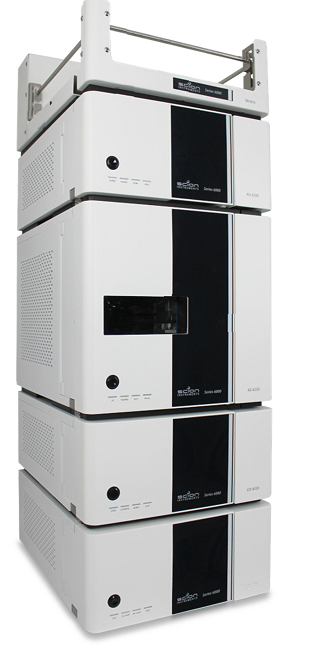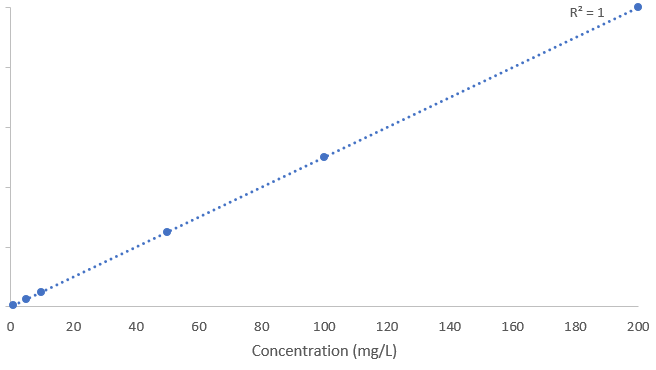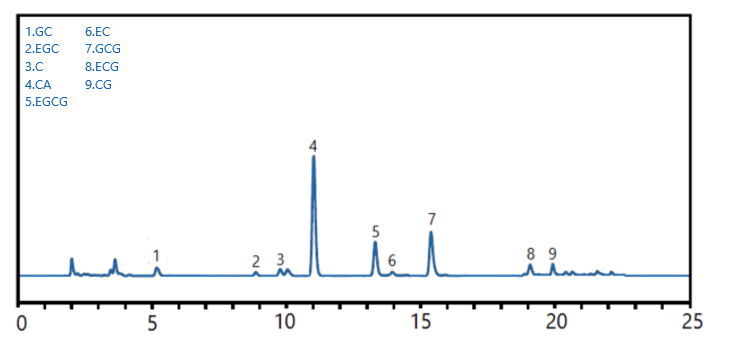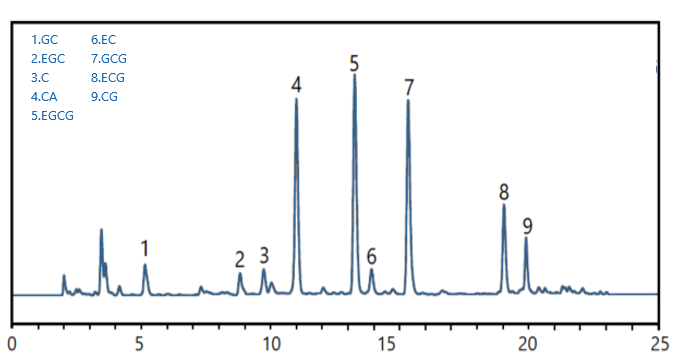Analysis of Catechins by HPLC-UV
Introduction
Hot beverages are one of the most widely consumed drinks worldwide, with tea becoming increasingly more popular. Camellia Sinensis, the leaves used during the production of tea. Studies have shown that tea provides several health benefits such as protecting against cardiovascular disease and the management of cholesterol and obesity [1]. The main antioxidants found in tea are catechins.
The composition of catechins in commercial teas vary due to the species of Camellia Sinensis used, horticultural conditions but most importantly, the degree of oxidation during the manufacturing process. Natural processes such as sun drying or steaming the leaves, therefore preventing oxidation, not only protects the tea flavour but also results in high catechin concentrations with lower caffeine amounts whereas harsh leaf processing results in lower catechins and higher caffeine concentrations. Due to the variability in the composition of catechins in tea, it is vital that catechins can be easily identified in a variety of tea products.
SCION Instruments developed a method for the identification of eight catechins commonly found in tea products as well as caffeine, by HPLC-UV.
Experimental
A SCION 6000 HPLC with UV was used with a C18 reverse phase column for the simultaneous identification of nine target compounds, shown in Figure 1.

Figure 1. SCION 6000 HPLC
An analytical standard containing all target analytes was analysed to demonstrate identification and separation of all compounds. Samples included commercially available bottled green tea and a green tea catechin supplement. Table 1 details the analytical conditions of the HPLC-UV.
Table 1. Analytical conditions of the SCION 6000 HPLC
| Conditions | |
| Column | C18 5µm x 4.6mm ID x 150mm |
| Column Temp | 40°C |
| Mobile Phase | A 0.05% Phosphoric Acid pH 2.4B Methanol: Acetonitrile (3:2) |
| Gradient | 0 min B:10% A:90%15min: B25% A75%
25min: B60% A 40% |
| Flow Rate | 1mL/min |
| Injection Vol | 10µL |
| UV | 280nm |
Results
Table 2 identifies all target compounds and associated abbreviations used throughout this application note.
Table 2. Target analytes and associated abbreviations
| Compound | Abbreviation | ||
| Gallocatechin | GC | ||
| Gallocatechin Gallate | GCG | ||
| Epigallocatechin | EGC | ||
| Epigallocatechin Gallate | EGCG | ||
| Epicatechin | EC | ||
| Epicatechin Gallate | ECG | ||
| Catechin | C | ||
| Catechin Gallate | CG | ||
| Caffeine | CA | ||
All target compounds were analysed in a concentration range of 1-50mg/L with the exception of caffeine (1-200mg/L). All target compounds gave a correlation coefficient of >0.999. Figures 2 and 3 show the calibration curve of EGC and CA, the two compounds with the lowest and highest R2 value.

Figure 2. Calibration curve of epigallocatechin (EGC) 1-50mg/L

Figure 3. Calibration curve of caffeine (CA) 1-200mg/L
Following the excellent linearity observed of all target compounds, both the green tea and green tea supplement were analysed. Figures 4 and 5 show the obtained chromatograms including peak identification.

Figure 4. Chromatogram and compound identification of green tea sample

Figure 5. Chromatogram and compound identification of the supplement
As shown in the above figures, the green tea and the green tea supplement exhibit the same catechin profile but at varying concentrations. The naturally derived green tea drink gave considerably lower catechin and caffeine concentrations compared to the supplement sample, which exhibited high levels of CA, EGCG and GCG.
Conclusion
SCION Instruments offers an easy solution for the simultaneous identification of eight target catechins plus caffeine using the SCION 6000 HPLC-UV system. Excellent separation and linearity was observed for all target compounds using a C18 column at 280nm wavelength.
Download Application Note
Download the complete Application Note: Analysis of Catechins by HPLC-UV
SCION 6000 HPLC
A SCION 6000 HPLC with UV was used to conduct this research. Providing excellent solutions for the simultaneous identification of nine target compounds. Find out more about the SCION HPLC 6000.
If you wish to speak to a member of our team for more information, please don’t hesitate to get in touch. Or to stay in the loop regarding future research and articles from SCION Instruments, why not join us on social media and sign up to our newsletter today?
